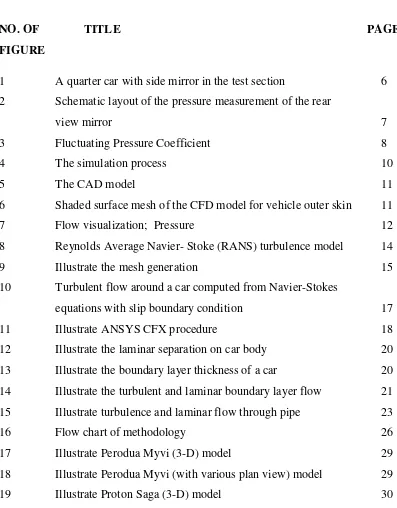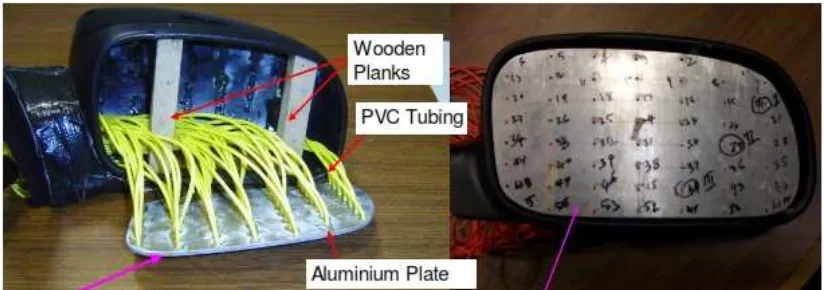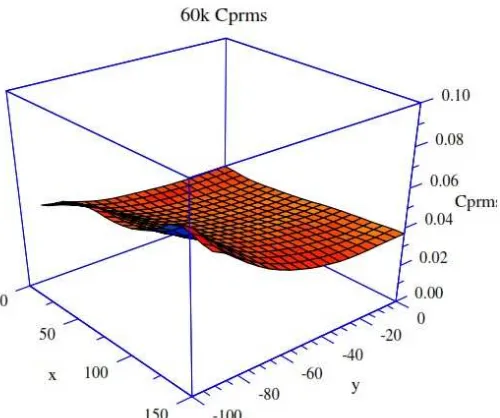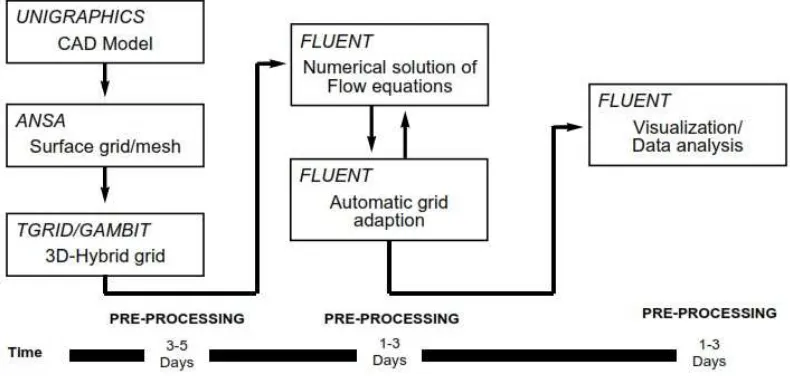i
SUPERVISOR DECLARATION
“I hereby declare that I have read this thesis and in my opinion this report is sufficient in terms of scope and quality for the award of the degree of
Bachelor of Mechanical Engineering (Automotive).”
ii
SIMULATION OF AIR FLOW AROUND A VEHICLE SIDE MIRROR
NUR ATIQAH BTE SHAHARI
This report is presented in
Partial fulfilment of the requirements for the
Bachelor of Mechanical Engineering (Automotive)
Faculty of Mechanical Engineering
Universiti Teknikal Malaysia Melaka
iii
DECLARATION
“I hereby declare that the works in this report is my own except for summaries and quotations which have been duly acknowledged.”
iv
To my beloved parents, Mr. Shahari Che Bakar and Mrs.Norasiah Abdul Karim... My family...
My Supervisor, Mr. Fudhail Bin Abdul Munir... My friends...
v
ACKNOWLEDGEMENT
First of all, I would to say Alhamdulillah. Praise to Allah with His bless,I am very thankful for giving chances and ability to complete this project. In addition, I would like to thank to my fellow friends who always encouraged me with this project.
Noted with thank to my helpful supervisor, Mr. Fudhail bin Abdul Munir whose help, stimulating suggestions and encouragement helped me in all the time of the research and writing of this Final Year Project.. All of the support and supervision from him is completely useful and it will not be forgotten. The opportunity he had willingly given to me is a very substantial key for me to serve better for the industry and educational field particularly.
vi
ABSTRACT
vii
ABSTRAK
viii
CONTENTS
CHAPTER TITLE PAGE
DECLARATION iii
DEDICATION iv
ACKOWLEDGEMENT v
ABSTRACT vi
ABSTRAK vii
CONTENTS viii
LIST O FIGURE xi
LIST OF SYMBOL xiii
CHAPTER 1 INTRODUCTION 1
1.1 Overview 1
1.2 Problem Statement 2
1.3 Objective 2
1.4 Scope 2
ix
CHAPTER 2 LITERATURE REVIEW 4
2.1 Overview 4 2.2 aerodynamic Effects on a Rear Side View Mirror 4 2.3 Simulation of airflow around an Ople Astra 9 2.4 Computational Fluid Dynamics (CFD) 12
2.4.1 Turbulence Model 13
CHAPTER 4 RESULT AND DISCUSSION 38
4.1 Overview 38
4.2 Flow Streamline and Pressure Distribution on Vehicle Models 38 4.3 Pressure and Velocity Variation on
x
CHAPTER 5 CONCLUSION AND RECOMMENDATION 48
5.1 Conclusion 48
5.2 Recommendation 49
REFERENCES 51
xi
LIST OF FIGURE
NO. OF TITLE PAGE
FIGURE
1 A quarter car with side mirror in the test section 6 2 Schematic layout of the pressure measurement of the rear
view mirror 7
8 Reynolds Average Navier- Stoke (RANS) turbulence model 14
9 Illustrate the mesh generation 15
10 Turbulent flow around a car computed from Navier-Stokes
equations with slip boundary condition 17
11 Illustrate ANSYS CFX procedure 18
12 Illustrate the laminar separation on car body 20 13 Illustrate the boundary layer thickness of a car 20 14 Illustrate the turbulent and laminar boundary layer flow 21 15 Illustrate turbulence and laminar flow through pipe 23
16 Flow chart of methodology 26
17 Illustrate Perodua Myvi (3-D) model 29
18 Illustrate Perodua Myvi (with various plan view) model 29
xii
20 Illustrate Proton Saga BLM (with various plan view) model 30
21 Illustrate Perodua Kenari (3-D) model 31
22 Illustrate Perodua Kenari (with various plan view) model 31
23 Standard 3D view (Perodua Kenari) 32
24 Standard 3D view (Perodua Myvi) 33
25 Standard 3D view (Proton Saga BLM) 34
26 Geometry meshing for 3D Perodua Kenari’s side mirror
simulations 36
27 Flow streamline on side mirror model (3D).
(a) Perodua Kenari, (b)Perodua Myvi and (c) Proton Saga BLM 40 28 Pressure distribution on side mirrror model (3D)
xiii
LIST OF SYMBOL
ρ
Density of air at 300K
V Free stream velocity
µ
Dynamics fluid viscosityRe Reynolds number L Characteristic length Cp Pressure coefficient P Pressure at the car
1
CHAPTER 1
INTRODUCTION
1.1OVERVIEW
This study has been carried out in order to study the flow around a vehicle side mirror. A side mirror also known as wing mirror is a mirror found on the exterior of motor vehicles. It is used to help the driver see rear areas and to the sides of the vehicle, outside of the driver's peripheral vision in the 'blind spot' [1].
Most modern cars mount their side mirror on the doors, normally at “A” pillar. The side mirror can be manually adjusted or by using remote for vertical and horizontal adjustment to produce enough coverage depends on driver height differences and seated position. As windscreen plays an important role in the overall design of a vehicle, side mirror also has its own role.
2
Two main objectives can be defined from this study. The first is to study the airflow characteristic around a vehicle side mirror and to obtain the flow pattern around a vehicle side mirror using Computational Fluid Dynamics (CFD). Comparison made between three national car models which are Proton Saga BLM, Perodua Myvi and Perodua Kenari to investigate the effect of the flow pattern. The result of this study hopefully can be used as a reference and guideline by other researcher.
1.2PROBLEM STATEMENT
As the main concern of automotive aerodynamics is reducing drag in order to reduce the roll resistance, drivers are always curious to see the effect in terms of fuel efficiency. In this study, the airflow pattern around a side mirror will be investigate and define. Comparison between three national car models which are Proton Saga BLM, Perodua Myvi and Perodua Kenari are made to investigate the effect of airflow pattern. Simulation and results of this study will show the airflow pattern for each selected national car model and the effect in terms of fuel efficiency will be discussed.
1.3OBJECTIVE
The objectives of this study are:
1. To study airflow characteristics around a vehicle side mirror. 2. To obtain the flow pattern around a vehicle side mirror using
3
1.4SCOPE
The scopes of this proposed project are:
1. Simulate airflow for different national cars model which is Proton
Saga BLM, Perodua Myvi and Perodua Kenari.
2. To investigate the flow pattern around a vehicle. 3. Simulation will be done using ANSYS 12.1.
1.5EXPECTED RESULT
4
CHAPTER 2
LITERATURE REVIEW
2.1 OVERVIEW
This chapter will discuss about interests related to the basic and background knowledge of side mirror, the aerodynamic theory and the used of Computational Fluid Dynamics (CFD) in defining the airflow around a vehicle side mirror. Reviews on previous studies concerning the airflow around a vehicle side mirror are included as well.
2.2 Aerodynamic Effects on an Automotive Rear Side View Mirror by By Alam,
R. Jaitlee and S. Watkins.
5
unsteady forces, leading to movement of the mirror surface and potential image blurring. This study has been carried out due to the objective is to experimentally determine the fluctuating base pressure on a standard and modified mirror using a half of the full-size vehicle, fixed to the side wall of RMIT Industrial Wind Tunnel as well as in isolation (without the half car)[2].
Driver’s vision can be impairs by pressure fluctuations from the wake of the side mirror view. Vibration of mirror glass due to the pressure fluctuations cause the potential of blurring image will consequently affect the safety of the vehicle and its occupants. Two major contributors to the driver’s vision are the location and functionality of vehicle side view mirrors. Some previous study has been carried out in order to define the structural input (engine, road/tyre interaction etc) and also the aerodynamic input to mirror vibration.
The mirror location in the vicinity of the A-pillar vortex provide complex problem. The strength and intensity is very high even the size of the A-pillar vortex is not very large at this location. Thus, the main objective of this project was to measure the aerodynamic pressure (mean and fluctuating) on the mirror surface in order to understand the aerodynamic effects on mirror vibration. Moreover, the mirror was modified by shrouding around the external periphery (24mm, 34mm, and 44mm extensions) to determine the possibility of minimization of aerodynamic pressure fluctuations and to see if this method would attenuate the fluctuating base pressures[2].
6
Figure 1: A quarter car with side mirror in the test section
A Dynamic Pressure Measurement System (DPMS) developed by Turbulent Flow Instrumentation (TFI) was used in order to measure the mean (time-averaged) pressures and fluctuating pressures (time-dependent) on the mirror.The DPMS is a multi-channel pressure measurement system that can accurately measure the fluctuating pressure up to 1000Hz depending upon tubing diameters and lengths[2].
7
Figure 2: Schematic layout of the pressure measurement of the rear view mirror
.
Mean, rms (standard deviation), minimum and maximum pressure value of each pressure port on mirror was provided by the DPMS data acquisition software Dimensions (diameter and length) of the tubing used was entered , then the data were linearized to correct for tubing response to obtain dynamic pressure measurements. The sampling frequency of each channel was1250 Hz. It may be noted that the peak energy of fluctuating pressure on mirror surface was well below 500 Hz. The mean and fluctuating pressures were measured at a range of speeds (60 to 120 km/h with an increment of 20 km/h) at zero yaw angles. The mirror was tested as standard and then modified by adding 24mm, 34mm and 44mm shrouding on the mirror periphery.
Fluctuating pressure coefficients (C p rms ) of three dimensional (3D) was
8
Figure 3: Fluctuating Pressure Coefficients (Cp rms) -3D - 60km/h
As the origin of the plot is located at the top left hand corner position, the x-distance is horizontal and y-x-distance is vertically down. The 3-D plots clearly determine that the fluctuating pressure is distributed non uniformly on mirror surface. It is most concentrated at lower central part of the mirror surface. While at low speeds, the maximum fluctuating pressure coefficients were measured at the bottom right part of the mirror surface. However, the magnitude of fluctuating pressure coefficients decreases with an increase of speeds. The maximum fluctuating pressure shifts towards the bottom central part of the mirror surface.
From the whole experiment, it should be noted that the results are for specific vehicle and mirror geometry. The experiment defined that the fluctuating aerodynamic pressure are non-uniformly distributed over the mirror surface. The central bottom sections of the mirror surface showed the highest magnitude of fluctuating pressure for the standard mirror. Moreover, the magnitude of the base pressure fluctuating can be reduced by extending the outer periphery of the typical automotive rear view mirror. This condition at the same time will change the pressure distribution across the mirror face.
9
aerodynamic inputs to mirror vibration. As the yaw angle is also known to affect mirror noise and vibration, this should also be considered in future work.
2.3Simulation of air flow around an Opel Astra vehicle with FLUENT by
Andreas Kleber
In this study, investigation has been done by using OPEL ASTRA as an example to show an efficient process for the simulation of the flow field around a vehicle. Individual steps involved in this simulation process include a special emphasis on mesh generation and adaptions are discussed. Applications of aerodynamic simulation in various areas are reviewed.
10
Figure 4: The simulation process
The simulation process is divided into following steps: CAD surface preparation, mesh generation, CFD solution of the fluid flow, mesh adaption, and visualization of the results. The software packages used for these steps include, UNIGRAPHICS (CAD), ANSA (CAD/mesh generation), TGRID and GAMBIT (additional mesh generation), and FLUENT (solver and post processing).
11
Figure 5: The CAD model[12]
Since the wind tunnel and the underbody have already been meshed, the description of the task of grid creation is limited to the styling surfaces. The window frames are covered with regular quadrilateral elements so as to close the stage of the window later using separately inserted prism blocks.
Figure 6: Shaded surface mesh of the CFD model for vehicle outer skin[12]
For numerical solution of flow equation and grid adaption,a 3D steady state incompressible solution of the Navier-Stokes equations was performed using FLUENT 5. Turbulence modeling was done with realizable k-using none





![Figure 5: The CAD model[12]](https://thumb-ap.123doks.com/thumbv2/123dok/570378.67468/24.595.122.524.421.555/figure-the-cad-model.webp)